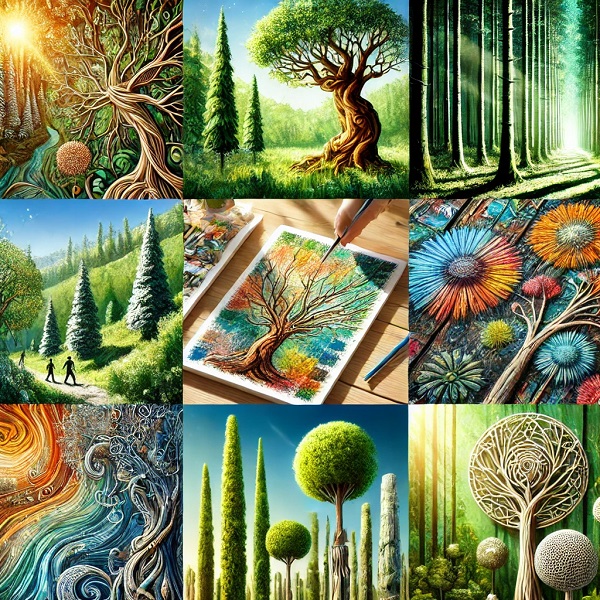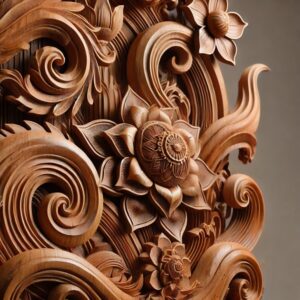Art Inspired by Nature: Embracing Tree Art

Tree art can be any artwork that involves trees, depicts trees, is made from trees, or is inspired by trees. It can be a living material that serves a higher purpose than aesthetics and can be used to confront our relationship with the natural world.
The Evolution of Tree Art
Tree art has been part of human culture for centuries. Early cave paintings and carvings often featured trees, symbolizing life, growth, and connection to nature. As societies evolved, so did the artistic representations of trees. In ancient cultures, trees were often worshipped and depicted in religious artifacts. In medieval Europe, trees were prominent in illuminated manuscripts, symbolizing knowledge and the divine.
In modern times, tree art has taken on new forms and meanings. Artists use trees and tree parts to create sculptures, paintings, and installations that challenge viewers to think about their relationship with the environment. Tree art can be both a celebration of nature’s beauty and a poignant commentary on environmental issues.
Sculptures and Installations: Transforming Trees
One of the most striking forms of tree art is sculpture. Artists like Andy Goldsworthy and Patrick Dougherty have become renowned for their work with natural materials, including trees. Goldsworthy’s ephemeral sculptures often use leaves, branches, and stones to create temporary works that interact with the environment. Dougherty, on the other hand, uses saplings and branches to create large-scale installations that invite viewers to walk through and experience the art from within.
These sculptures not only highlight the beauty of trees but also emphasize their impermanence. By using natural materials that will eventually decay, these artists remind us of the transient nature of life and the importance of preserving our natural world.
Painting and Photography: Capturing the Essence of Trees
Painting and photography have long been mediums through which artists explore the beauty and complexity of trees. From the impressionist landscapes of Claude Monet to the stark black and white photographs of Ansel Adams, trees have been a central subject in visual art.
Contemporary artists continue this tradition, using various techniques to capture the essence of trees. Some, like David Hockney, use bright colors and bold strokes to convey the vibrancy of forests. Others, like Beth Moon, use long exposure photography to capture the ethereal quality of ancient trees under the night sky.
These artworks not only celebrate the beauty of trees but also encourage viewers to see them in new and unexpected ways.
Eco-Art: Trees as Living Canvases
Eco-art is a growing movement that uses natural materials and living organisms to create art that addresses environmental issues. Trees often play a central role in these works, serving as both subject and medium.
One notable example is the Tree Circus in Gilroy, California, where artist Axel Erlandson shaped living trees into intricate designs. Erlandson’s work is a testament to the possibilities of tree art and a reminder of the delicate balance between human creativity and nature.
Another example is the work of Agnes Denes, who planted a forest on top of a landfill in New York City. Her “Tree Mountain – A Living Time Capsule” is an ecological artwork that aims to restore degraded land and create a habitat for wildlife.
These projects highlight the potential of tree art to make a positive impact on the environment and inspire others to think creatively about sustainability.
Woodworking and Craft: Celebrating the Material
Woodworking is another form of tree art that has deep cultural roots. From ancient furniture-making techniques to modern carpentry, the use of wood as a material for art and functional objects has been a part of human history for millennia.
Contemporary woodworkers like George Nakashima and Mira Nakashima have elevated woodworking to an art form, creating pieces that celebrate the natural beauty of wood. Their work emphasizes the unique grain patterns and textures of different tree species, turning functional objects into works of art.
Woodworking not only honors the material but also encourages sustainable practices. By using locally sourced and reclaimed wood, artists can reduce their environmental impact and promote the responsible use of natural resources.
The Future of Tree Art
As our understanding of the environment and our impact on it continues to evolve, so too will the ways in which artists engage with trees. Future tree art will likely explore new materials and techniques, pushing the boundaries of what is possible.
One promising area is the use of technology in tree art. Artists are beginning to experiment with sensors and data visualization to create interactive installations that respond to environmental changes. These works have the potential to deepen our understanding of trees and their role in the ecosystem.
Tree art will continue to be a powerful medium for exploring our relationship with nature. By celebrating the beauty and complexity of trees, artists can inspire us to appreciate and protect the natural world.



